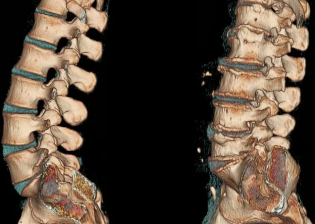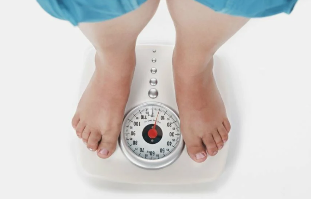Osteochondrosis — a chronic relapsing disease, running in the background the constant degradation of the vertebrae and intervertebral discs. Depending on the localization of the structures of vertebrate animals, exposed degenerative changes, we distinguish between thoracic, lumbar-sacralis pathology, as well as the neck. The head of the symptoms of degenerative disc disease — pain, whose severity increases during physical exertion, stiffness of movements. In the clinical picture often occur vertebrae symptoms: headache, jumps in blood pressure, reduction of visual acuity and hearing.

Diagnosis is established on the basis of the results of instrumental research — x-ray, MRI, CT. In the therapy of degenerative disc disease with used drugs different also clinical-pharmacological groups. To increase their clinical effectiveness by physiotherapy and massage. One of the main methods of treatment and prevention is a therapeutic physical education.
The mechanism of the development of the disease
On the basis of the pathogenesis of degenerative disc disease lies the loss of the nucleus pulposus of their hydrophilic properties. This semi-liquid dough, the structure consists of connective tissue fibers and a gelatinous substance. As they mature a person is the reduction of the vascular bed in each disk between the vertebrae. Enroll in him, the nutrients is going to diffuse, i.e. on the principle of spontaneous equalization of concentrations. This explains the impossibility of complete recovery of cartilage tissue after injury or excessive physical stress on the spine.
Processes degenerative disc disease exacerbated by changes in the hormonal background and an unbalanced diet. In cartilage tissue reaches sufficient for their normal functioning the amount of nutrients, which raises the following violations of their structure and properties:
- forfeit strength and flexibility;
- changes the shape, consistency and configuration.
The intervertebral disc flattened, and the fibrous ring to form radial cracks. It becomes the cause of reduction of the distance between the adjacent vertebrae. Gradually in the disease process to involve the connective tissue of the fibrous rings, the ligaments. In response to the disintegration of the tissue, the immune system starts to produce immunoglobulins, which leads to aseptic inflammation and swelling in the joints and surrounding soft tissue. Capsules of the joints are stretched, so the intervertebral discs will stop safely fixes the vertebrae. And in the instability of intervertebral segments increases the likelihood of retention of the nerve root or squeezing the blood vessels. This often happens when the cervical osteochondrosis and becomes the cause of its pronounced symptomatology.
Causes and precipitating factors
On the condition of the intervertebral disc affects the weakened tone of the skeletal muscles of the spinal column. Irrational, give it an asymmetrical functioning of the muscles occurs during prolonged residence of man in a no-salt position, for example, with the head while working at the computer. Trigger destruction of the cartilage tissue can constant wearing heavy bags on one shoulder, sleeping on a soft mattress and high pillow.
Accelerate the destruction of the intervertebral discs also have the following external and internal negative factors:
- endocrine and metabolic disorders;
- infectious diseases, in particular chronic;
- previous spinal injuries (compression fractures, bruises);
- frequent hypothermia;
- the availability of systemic or degenerative-degenerative disc disease — gouty, psoriatic, rheumatoid arthritis, joint arthrosis, osteoporosis.

If a person has bad habits, then it is in danger. Smoking and alcohol abuse worsen the condition of blood vessels, leading to sub-optimal blood circulation and to the lack of nutrients in the cartilage tissue of the disk.
In the presence of flat feet or clubfoot significantly increases the risk of developing degenerative disc disease of any localization. As congenital or acquired defects are the reason for the increase in the load on the spine due to the inability to ensure the proper depreciation with the support. Predisposing to the emergence of the pathology factor is obesity.
In the sediment of adipose tissue on the different parts of the body complicates the support of balance, which leads to the action of excessive load on the intervertebral joints.
The clinical picture
The first clinical manifestations of the cervical, thoracic or lumbar degenerative disc disease — pain in the back. During relapse is penetrating, radiating in located in the vicinity of the parts of the body. The slightest movement leads to an increase in the severity of the pain syndrome. The reactions of a person becomes the adoption of the forced position in which the intensity of unpleasant excitement is minimal:
- people with cervical osteochondrosis prefer to turn to the side not the head, but the whole body;
- in thoracic pathology a person afraid to even do a full inhale, because it becomes the cause of acute pain in the thoracic region;
- patients with lumbar osteochondrosis heavily sitting, standing and walking due to compression of the spinal nerve.
Most of the patients, the doctors complain of constant dull pain and feeling of stiffness movements in the morning. This requires additional differential diagnosis to exclude myositis (an inflammatory process in the skeletal muscles of the back) and joint arthrosis. The reason for the occurrence of the pain, pressing in the head — compensation voltage of muscle tissue for stabilization of the affected vertebral motion segment. Constant pain syndrome weak or moderate severity also arises as a result of significant stretching of the intervertebral discs and the development of aseptic inflammation.
For degenerative disc disease of a certain localization is the typical specific symptoms. For example, when the lumbar pathology often occurs sciatica — attack of pain in the lumbar and the back of the thigh. Thoracic osteochondrosis clinically manifested by visceral pain in heart area, in the right hypochondrium, of the abdomen, numbness, increased sensitivity of the skin, the crunch of the vertebrae. But the most clearly expressed and varied symptoms of different pathology, which affects the neck of the intervertebral disc.
Due to the displacement of the vertebrae, forming osteophytes squeezed the vertebral artery propulsion of brain cells, providing them with oxygen. A person suffers from disorders of coordination of movements, noise in the ears, headaches, hypertension.
What could be if left untreated
Most of the complications of degenerative disc disease arise due to the occurrence of hernia of the intervertebral disc. It is formed when the bias of the vertebrae patterns back, which leads to rupture of the posterior longitudinal ligament. The Disk becomes more unstable, and part of his bulges into the spinal canal. This is considered to be a hernia, if they are in the process of his education together with a disc in the channel penetrates his purposee core.
It's a morbid condition of the vertebrate structures predisposes to spinal cord compression and the development of discogenic myelopathy. Clinically manifests itself in a torpor, weakness of some muscle groups of the feet or the hands, paresis, muscle atrophy, changes in tendon reflexes. Can be observed also disorders of emptying the bladder and / or bowel. Due to the emergence of betweenobratleth hernia compressed the arteries, nourishing the spinal cord. Are formed by the ischemic land on which killed all the nerve cells. Arises the so-called neurological deficit — broken movements, numbness, upset trofika.

Tactics of treatment
Osteochondrosis is not suitable for a complete cure, because as long as it is not synthesized drugs, the income of which would help to restore the damaged intervertebral disc and the vertebrae. But in the therapeutic scheme necessarily included chondroprotectors — symptomatic means occurs. Prefer the medicines with active ingredient chondroitin sulfate and (or) glucosamine sulfate (hydrochloride).
The clinical effectiveness of these drugs is confirmed by the results of years of research. In chronic (from 3 months to 2 years) of financial resources occurs partial regeneration of cartilage tissue, as well as other connective tissue structures — ligaments, tendons, bursa. Accumulation in the intervertebral discs of glucosamine and chondroitin to begin to develop, expressed as a analgesic, protiotokový, anti-inflammatory action. This will allow you to reduce the dose of NSAIDS, corticosteroids, muscle relaxation, reduction and the pharmacological burden on the body.
Medications on the joints ineffective in irregular reception, or their use for the treatment of degenerative disc disease of the 3 degrees, when it came to the destruction of a significant sample of cartilage tissue.
For the removal of symptomatology, usually emerging in the cervical or thoracic osteochondrosis, drugs are used to improve blood circulation, nootropics, the drug, improve the microcirculation of the labyrinth, used in the pathology of the vestibular apparatus.
If it is necessary in the treatment regimens are included antidepressants, anticonvulsant agents.
In the treatment of degenerative disc disease applies physiotherapy: UHF-therapy, magnetic therapy, laser. Use reflexology, massage, exercise therapy, hirudotherapy, swimming, yoga. When ineffectiveness of conservative treatment, the patient is shown a surgical procedure. Practiced puncture evaporation drive, laser reconstruction or replacement of the implant.
















